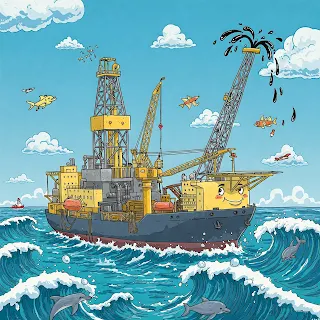Understanding Offshore Drilling
Offshore drilling is a critical part of the global energy industry, allowing companies to extract oil and natural gas from beneath the ocean floor. As demand for energy continues to rise, offshore drilling plays a key role in ensuring a steady supply of hydrocarbons. But how does it work, and what are the key components of an offshore drilling operation? In this guide, we will explore the types of offshore rigs, the major offshore-producing regions, and the environmental considerations surrounding offshore drilling.
Types of Offshore Rigs
The offshore drilling industry utilizes various types of rigs, each suited for specific water depths and geological conditions. Below are the main types of offshore rigs:
1. Jack-Up Rigs
Jack-up rigs are mobile, self-elevating platforms used for shallow-water drilling (up to 400 feet deep). They have retractable legs that are lowered to the seafloor for stability while drilling. These rigs are commonly used in the Gulf of Mexico and the North Sea.
2. Semi-Submersible Rigs
Designed for deeper waters (up to 10,000 feet), semi-submersible rigs float on large pontoons and use ballast systems to maintain stability. These rigs are favored for their ability to withstand harsh weather conditions, making them ideal for deep-sea drilling in regions like the North Atlantic and offshore Brazil.
3. Drillships
Drillships are large vessels equipped with drilling apparatus and dynamic positioning systems to stay on location in ultra-deep waters (up to 12,000 feet or more). These ships are highly maneuverable and are often deployed in deepwater regions such as the Gulf of Mexico, West Africa, and offshore South America.
4. Fixed Platforms
These permanent structures are used for long-term drilling and production in relatively shallow waters. Fixed platforms are anchored to the seabed and can accommodate multiple drilling wells. The Arabian Gulf and California coastline are home to many fixed platforms.
5. Tension-Leg Platforms (TLPs) & Spar Platforms
Tension-leg platforms and spar platforms are designed for deepwater drilling while maintaining a fixed position. TLPs use vertical tendons anchored to the seabed, while spar platforms use a deep-draft cylindrical hull for stability. They are commonly used in offshore fields in the Gulf of Mexico and West Africa.
Major Offshore-Producing Regions
Several regions around the world serve as hotspots for offshore drilling. Here are some of the most significant:
- Gulf of Mexico (U.S. & Mexico) – One of the world’s most active offshore drilling areas, known for both shallow-water and deepwater production.
- North Sea (U.K. & Norway) – A mature offshore region known for harsh weather conditions and high-quality crude oil.
- West Africa (Nigeria, Angola) – A growing deepwater hub with significant oil and gas reserves.
- Brazil (Pre-Salt Basin) – Home to ultra-deepwater reserves that have attracted major international investments.
- Middle East (Persian Gulf) – Contains some of the world’s largest offshore oil fields, primarily in Saudi Arabia, the UAE, and Iran.
- Southeast Asia (Malaysia, Indonesia) – An established offshore drilling region with a mix of shallow and deepwater projects.
Environmental Concerns and Safety Measures
While offshore drilling is essential for meeting global energy needs, it also raises environmental concerns. Some of the major issues include:
Oil Spills
Accidental spills, such as the Deepwater Horizon disaster in 2010, highlight the risks associated with offshore drilling. Companies invest heavily in blowout preventers (BOPs) and other safety measures to reduce these risks.
Marine Ecosystem Impact
Drilling activities can disrupt marine habitats, affecting fish populations and coral reefs. Strict environmental regulations help mitigate these impacts.
Carbon Emissions
The oil and gas industry contributes to greenhouse gas emissions. Many companies are investing in carbon capture and storage (CCS) technologies to reduce their environmental footprint.
Regulatory Compliance
Governments worldwide enforce strict regulations on offshore drilling to protect the environment and ensure safety. Agencies like the Bureau of Safety and Environmental Enforcement (BSEE) in the U.S. oversee offshore operations.
Conclusion
Offshore drilling is a complex yet vital process that fuels the global economy. Understanding the different types of rigs, key offshore-producing regions, and environmental challenges provides valuable insight into this high-stakes industry. As technology advances and environmental regulations become stricter, offshore drilling operations will continue to evolve, balancing energy demands with sustainability efforts.
For more expert insights on the oil and gas industry, subscribe to Oilfield Intel and stay ahead of the latest trends and developments.

Comments
Post a Comment